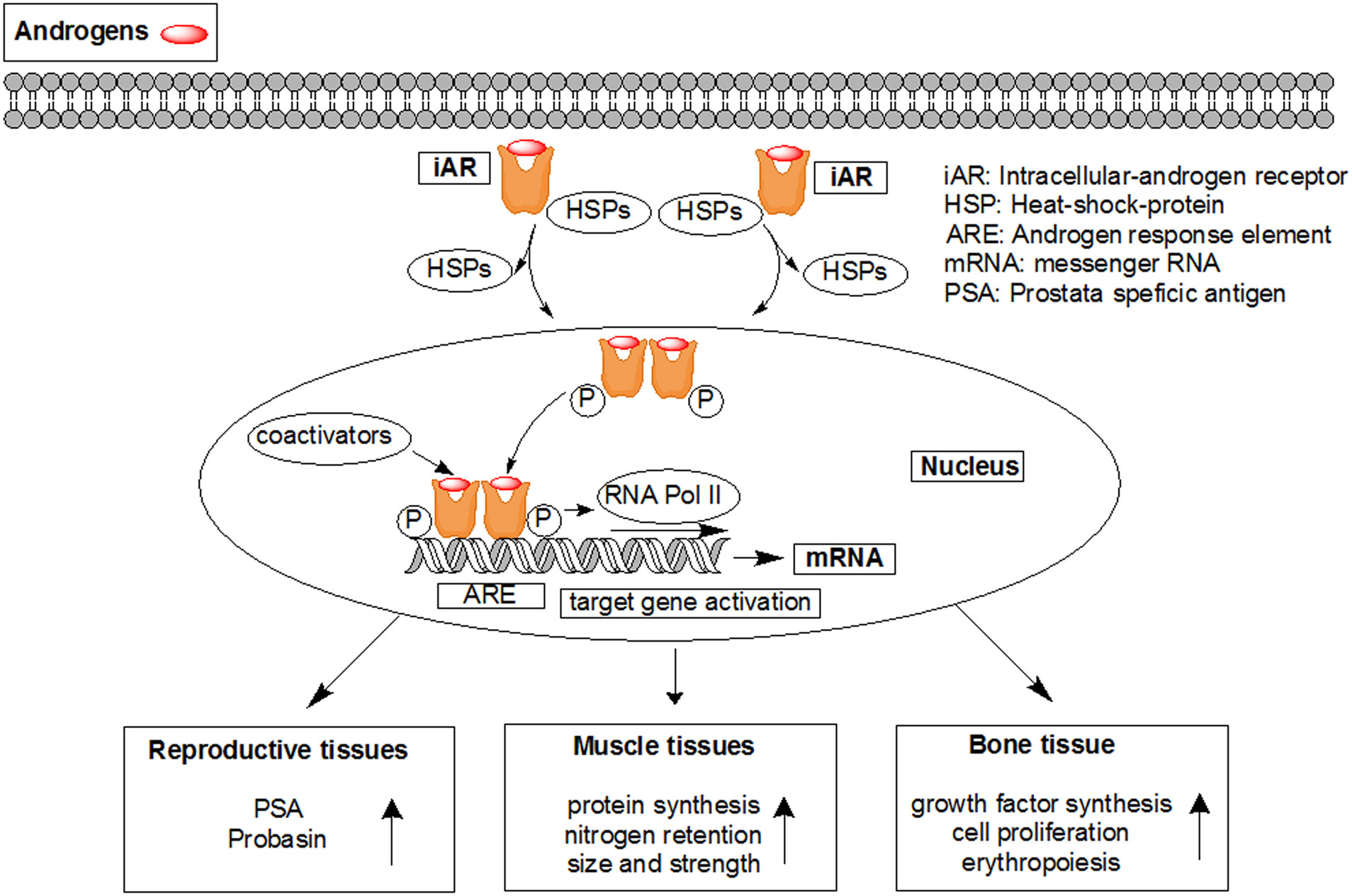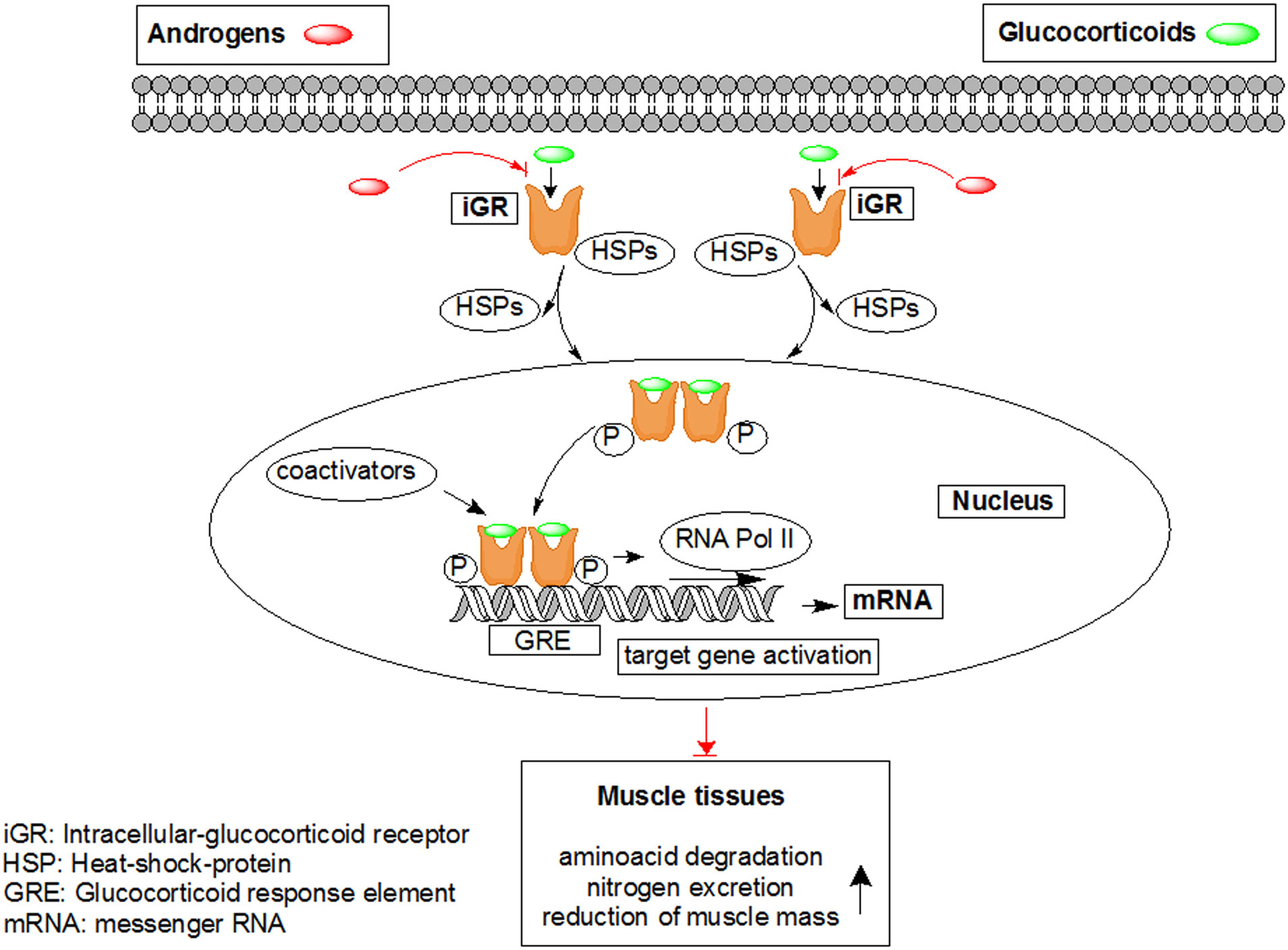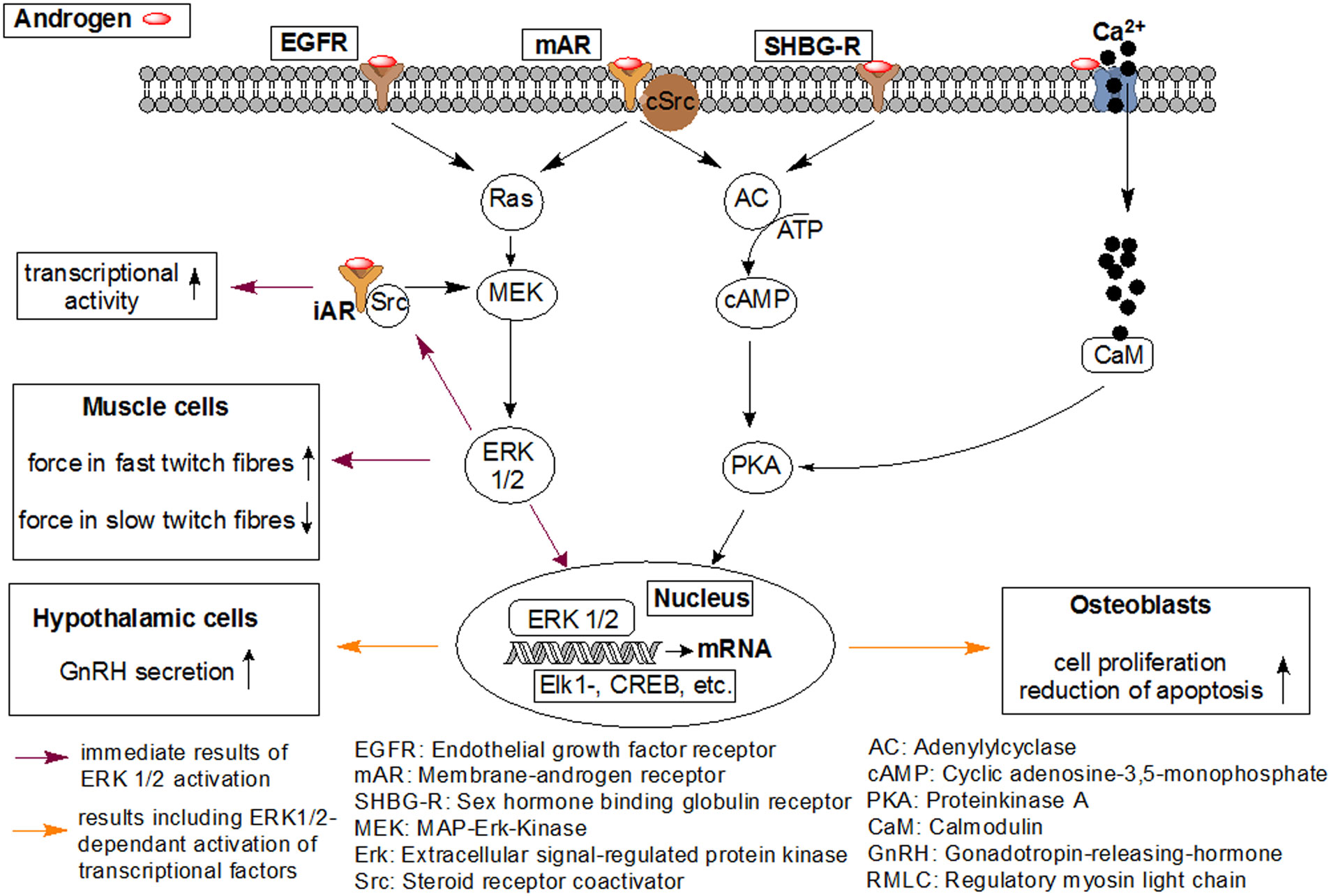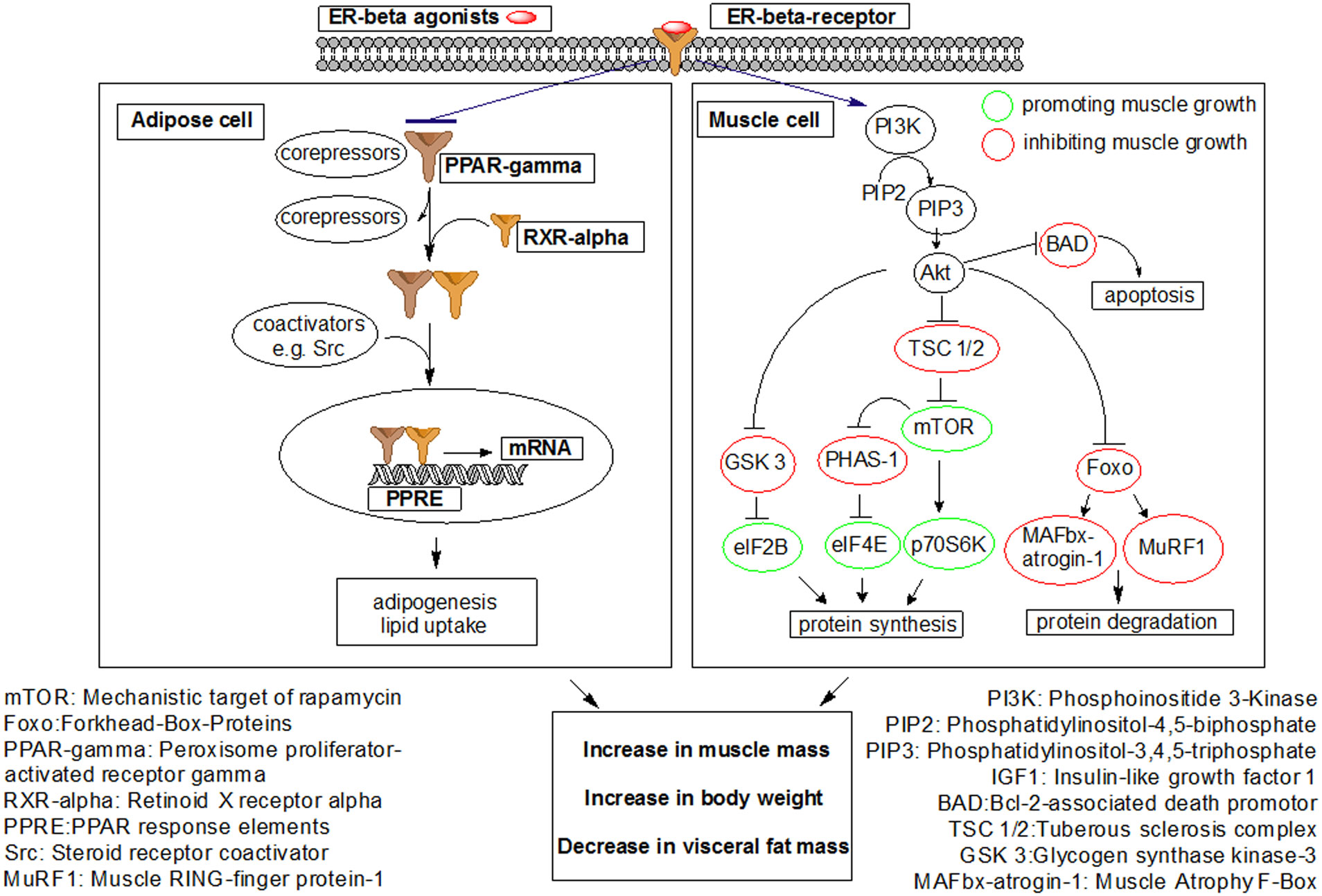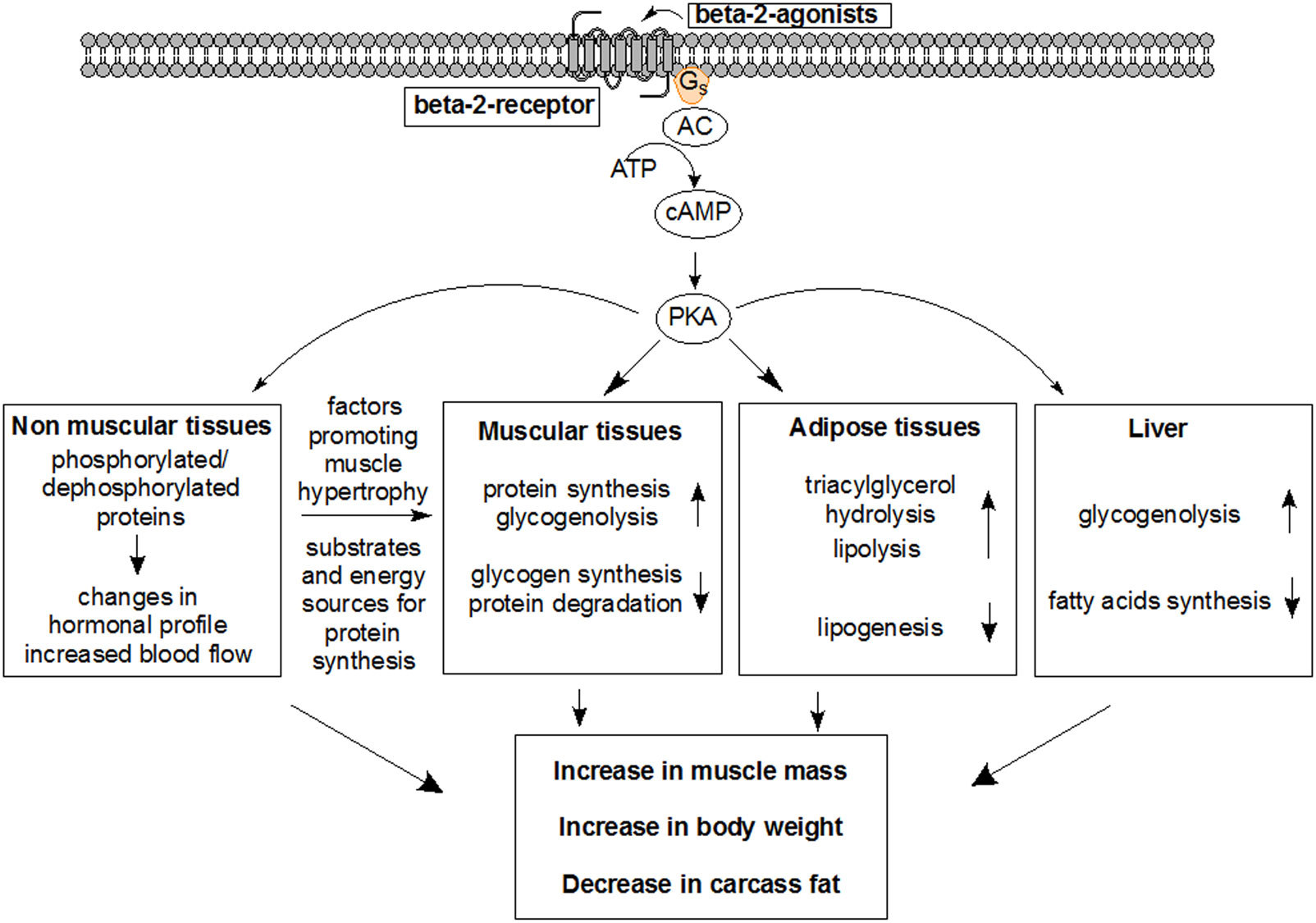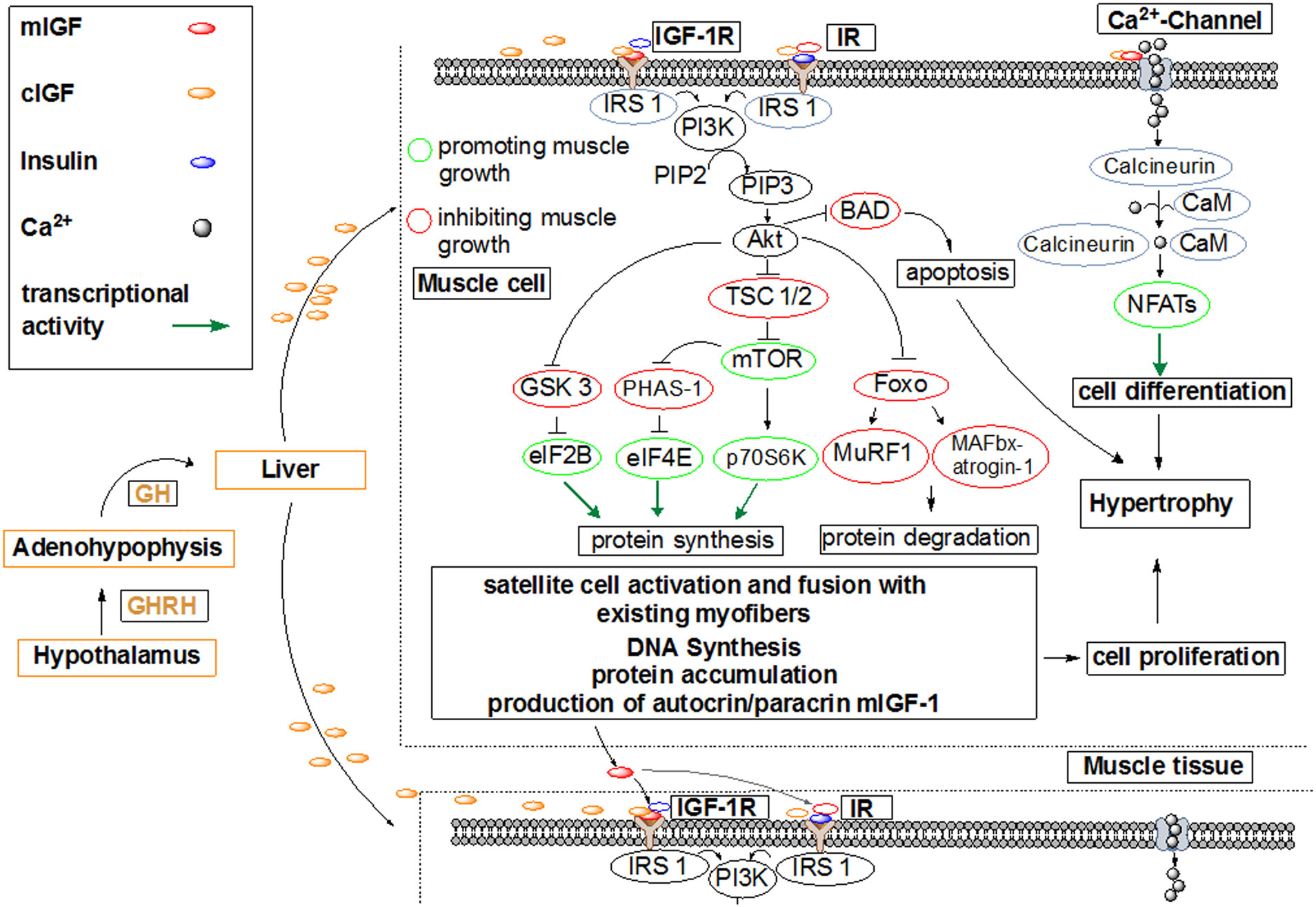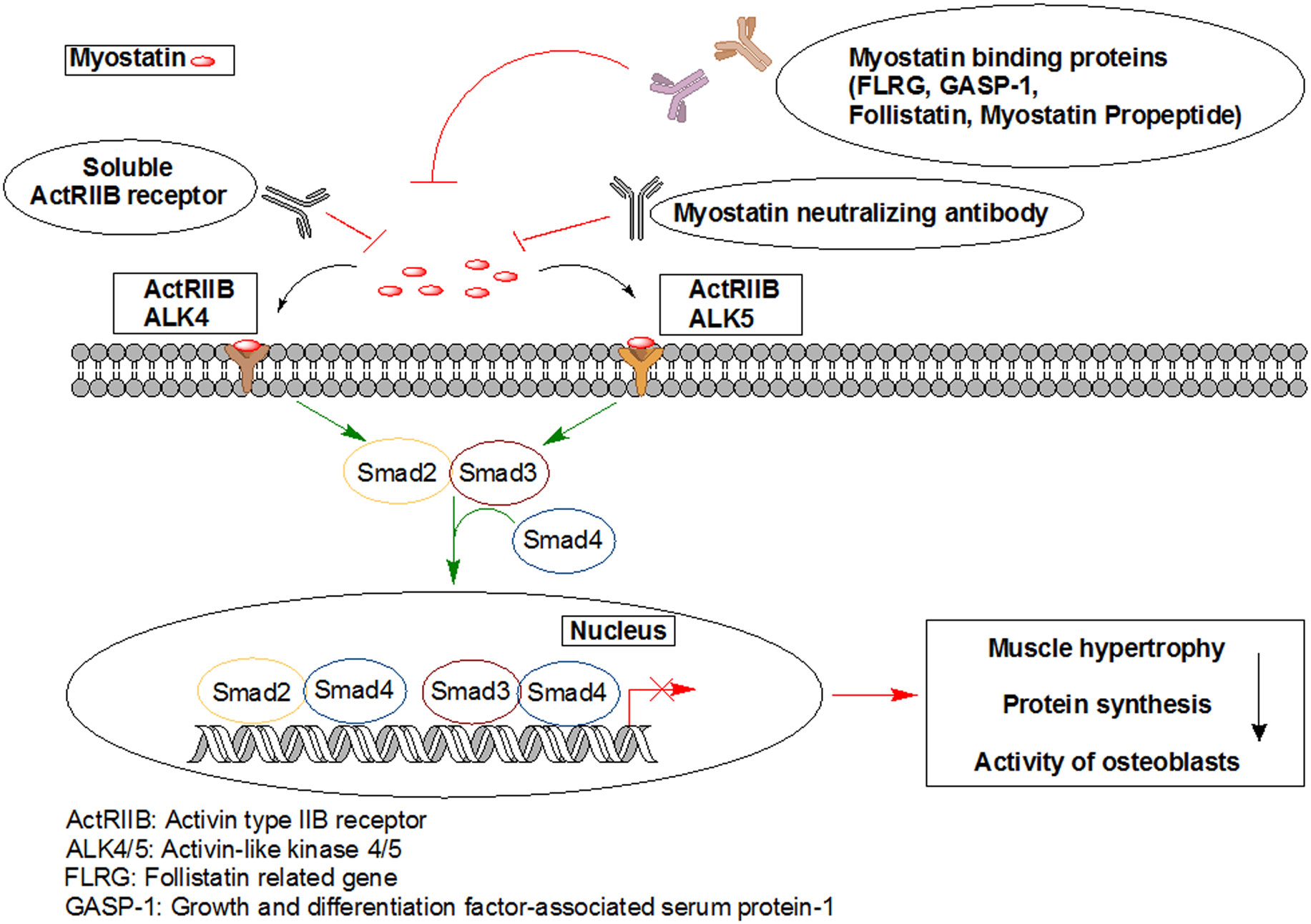Doping with performance enhancing substances in professional andamateur sports has increasingly gained awareness. Furthermore, not only thenumber but also the variety of substances detected in sports has increased.Intending muscle growth, anabolic androgenic steroids (AAS) have beencomplemented by selective androgen receptor modulators (SARMs), β2-adrenergicagonists, estrogen receptor (ER) β agonists and peptide-hormones like growthhormone (GH), insulin-like growth factor-1 (IGF-1) and insulin. However, withrespect to therapeutic use, drugs which increase anabolic actions in the bodyare highly desired for treatment of cachexia, sarcopenia, etc.
The aim of the following review is to elaborate on the agents’similarities and differences in mechanisms inducing muscle hypertrophy whilegiving an overview of the relevant signalling cascades. In addition to that,potential agents for treatment of catabolic diseases are identified.Information, onwhich this paper is based on, hasbeen collected from various publications which have been published inhigh-quality scientific journals.
The insight obtained has shown that signalling pathways mediatinggenomic actions of steroids have already been well-characterised, while thereis still need for further research on the mechanisms of non-genomicactions and downstream pathways as well as on those of SARMs and β2-adrenergicagonists’ action. A new and promising target is the estrogen receptor β. Theuse of ER-β agonists, which are proposed to activate anabolic mechanismsindependently from androgen receptor activation, may prevent the non-desiredandrogenic effects, which are associated with AAS administration. Thus, theymay be considered a promising alternative for treatment of diseases, whichcause loss of muscle mass and cachexia. In this context, phytoecdysteroids,such as ecdysterone etc, are considered as an interesting class of substances,where further investigations are highly desired. Furthermore, some peptidehormones also promote muscle hypertrophy. The signalling mechanisms of growthhormone, IGF-1 and insulin are summarised. Finally, the potential of myostatininhibition is discussed.
1.
Introduction
Networked control systems (NCSs) have been widely studied and applied in many fields in the past few decades, including DC motor [1], intelligent transportation [2], teleoperation [3], etc. Compared with traditional feedback control systems, the components in NCSs transmit data packets through communication networks, which reduce wiring requirements, save installation costs, and improve the maintainability [4]. However, public and open communication networks are vulnerable to malicious attacks by hackers. Cyber attacks can not only disrupt data transmission but also indirectly cause controlled plants to malfunction and stop operating by injecting fake data [5]. For example, in 2011, the "Stuxnet" virus invaded Iran's Bolshevik nuclear power plant, causing massive damage to its nuclear program [6]; in 2015, the "BlackEnergy" trojan virus successfully attacked Ukraine's power companies and cut off the local power supply [7]. Therefore, the security of NCS under cyber attacks has received increasing attention, and many illuminating results have been reported (see surveys [8,9]).
Current cyber-attacks may be roughly divided into two categories: denial of service (DoS) attacks and deception attacks. DoS attacks can cause network congestion or paralysis by sending a large amount of useless request information, thereby blocking the transmission of signals [10,11]. Compared to the simple and direct blocking of signal transmission in DoS attacks, deception attacks are more subtle and difficult to detect. More specifically, deception attacks compromise data integrity by hijacking sensors to tamper with measurement data and control signals. In some cases, they may be more damaging than DoS attacks [12]. Therefore, many researchers have conducted analysis and synthesis of NCSs under deception attacks. For instance, Du et al. [13] presented stability conditions for wireless NCSs subjected to deception attacks on the data link layer, and determined the maximum permissible deception attack time. Hu et al. [14] examined discrete-time stochastic NCSs with deception attacks and packet loss, and gave security analysis and controller design. In [15], Gao et al. investigated nonlinear NCSs faced with several types of deception attacks, and proposed asynchronous observer design strategies. Notably, the existing literature characterized the random occurrence of deception attacks by introducing a stochastic variable that obeys the Bernoulli distribution with a fixed probability, which is over-limited in reality.
In previous literature on NCSs, control tasks are often executed in a fixed/variable period, giving rise to the so-called sampled-data control (time-triggered control) [16,17,18,19]. Although this control scheme is simple and easy to implement, it has two shortcomings. On the one hand, to stabilize the system in some extreme scenarios, it is necessary to set a small sampling interval, which results in a large number of redundant data packets and may cause network congestion. On the other hand, due to the lack of a judgment condition for the system state, even if the stabilization of the system is achieved, the sampling task will not stop, which is undoubtedly a waste of network resources. In contrast to the time-triggered scheme (TTS), the event-triggered scheme (ETS) can significantly conquer these shortcomings and save communication resources [20,21,22]. In the ETS, the execution frequency of the control task is limited by introducing an event generator. That is, only when the change in system state exceeds a given threshold, an event will be generated and the controller will execute [23,24,25]. Based on the above facts, a multitude of studies have been conducted on event-triggered control for NCSs suffering from deception attacks (see [26,27,28,29,30]). However, most ETS designs under deception attacks adopted the periodic event-triggered scheme (PETS). The PETS can avoid the Zeno phenomenon by periodically checking the event trigger conditions but inevitably lose some system state information. To resolve this contradiction, Selivanov et al. proposed a switched event-triggered scheme (SETS) [31]. By switching between TTS and continuous event triggering [32], the SETS not only avoids the Zeno phenomenon, but also fully utilizes the system information, thereby further reducing the number of event triggers [33,34,35,36].
Inspired by the above facts, the subject of this study is SETS-based stabilization for NCSs under random deception attacks. By means of the Lyapunov function method, a sufficient condition is developed to assure that the close-loop system is mean square exponentially (MSE) stable. Then, a co-design of the trigger and feedback-gain matrices for the SETS-based controller is presented in terms of linear matrix inequalities (LMIs), which can be checked easily. The major contributions can be outlined as follows: 1) A new SETS (NSETS), which additionally introduces a term concerning the last event triggering time, is designed. In contrast to the SETS in [31], the NSETS can further reduce the number of trigger times while maintaining performance. 2) Compared with the existing literature (see, e.g., [28,29,30]), the occurrence of deception attacks under our consideration is assumed to be a time-dependent stochastic variable that obeys the Bernoulli distribution with probability uncertainty, which is more realistic. 3) Stability analysis criterion and computationally tractable controller design strategy are presented by utilizing a piecewise-defined Lyapunov function together with a few matrix inequalities.
Notation. In this paper, we use $ \mathbb{R}^{m\times n} $ and $ \mathbb{R}^{m} $ to denote $ m\times n $-dimensional real matrices and $ m $-dimensional Euclidean space, respectively. For each $ Z \in \mathbb{R}^{m\times n} $, we use $ Z < 0 $ $ (Z\leq 0) $ to indicate that the matrix $ Z $ is real symmetric negative definite (semi-negative definite), $ \mathcal{S}\{Z\} $ to denote the sum of $ Z+Z^{T} $, and $ \lambda_{M}(Z) $ and $ \lambda_{m}(Z) $ to represent the maximum eigenvalue and the minimum eigenvalue of the symmetric matrix $ Z $, respectively. We use $ ||\cdot|| $, $ \mathcal{P}_{r} $, and $ \mathcal{E} $ to represent the Euclidean norm, probability operator, and expectation operator, respectively. In addition, we use $ diag\{\cdot\} $ to denote a diagonal matrix and $ * $ to denote a symmetric term in a symmetric matrix.
2.
Preliminaries
In this section, we first give the system description, deception-attack model, and NSETS design, and then formulate the switched closed-loop system.
Consider a linear time-invariant system (LTIS) described as
In system (2.1), $ {A} $ and $ {{B}} $ are known system matrices of suitable dimensions, $ x(t)\in \mathbb{R}^{n_{x}} $, $ u(t)\in \mathbb{R}^{n_{u}} $, denote the state, control input, respectively.
In the event-triggered NCS, an event generator is used to determine whether the lately sampled data should be forwarded to the controller. When cyber-attacks do not happen, any state signals that satisfy the triggering condition can be received successfully by the controller, and the corresponding control signals can be received successfully by the actuator. However, when the communication network is subject to deception attacks, the control signal will be substituted with fake data, the performance of the controller will inevitably decline, and even lead to system instability in some extreme cases.
In view of the openness of network protocols, it is quite possible that attackers can inject the information transmitted in NCSs with fake data. In this paper, we suppose that the deception signal $ d (x(t)) $ satisfying Assumption 1 will totally substitute the original transmission data.
Assumption 1. [26] The signal of deception attack $ d(x(t)) $ satisfies
where $ D $ is a real constant matrix.
To demonstrate the randomness of deception attacks, a Bernoulli variable $ \beta(t) \in \{0, 1\} $ with uncertain probability is introduced:
Clearly, $ \mathcal{E}\{\beta(t)\} = \alpha +\Delta \alpha (t) $. Then, the signal transmitted under deception attacks can be presented as
Remark 2.1. Motivated by [26,27,28,29,30], the deception attacks are assumed to be randomly occurring. However, different from these references, this paper supposes that the probability of deception attack occurrence allows for some uncertainty; that is, there is a small positive constant $ \bar{\alpha} $ such that $ ||\Delta \alpha (t)||\leq \bar{\alpha} $.
Taking into consideration the constrained network resources, a NSETS is devised as follows:
where $ t_{\sigma} $ is the last triggering moment with $ \sigma\in \mathbb{N} $, $ M > 0 $ is a trigger matrix to be determined, $ h > 0 $ and $ \varepsilon_{i} $ ($ i\in \{1, 2\} $) are predefined parameters that stand for the waiting interval and triggering thresholds, respectively.
Remark 2.2. Inspired by [31,33,34,35,36], the SETS is used in this paper. However, unlike the existing SETSs, the proposed NSETS introduces an additional term $ \varepsilon_{2} x^{T}(t_{\sigma})M x(t_{\sigma}) $ into the trigger condition to more efficiently utilize the state information at the current moment and previous triggering moment. The introduced $ \varepsilon_{2} x^{T}(t_{\sigma})M x(t_{\sigma}) $ increases the difficulty of the event triggering and, therefore, prolongs the interval between triggered events.
In accordance with the proposed NSETS, the control input of system (2.1) under deception attacks with uncertain probability can be designed as
where $ K $ is the feedback gain that remains to be determined.
Then, we introduce $ \mathcal{T}_{\sigma}^{1} = [t_{\sigma}, t_{\sigma}+h) $ and $ \mathcal{T}_{\sigma}^{2} = [t_{\sigma}+h, t_{\sigma+1}) $, under event-triggered controller (2.5), system (2.1) can be characterized as
where $ \sigma\in\mathbb{N} $ and $ e(t) = x(t_{\sigma})-x(t) $ satisfying
Remark 2.3. Unlike general ETSs, the controlled system with the SETS needs to switch between periodic sampling and continuous event triggering to ensure the performance of the system. Inspired by [31], we denote the sampling error and triggering error by $ \int_{t_{\sigma}}^{t}\dot{x}(s)ds $ and $ e(t) $, respectively, and rewrite the controlled system as switched system (2.6) with two different modes.
Next, we introduce a definition of mean square exponential stability and several lemmas.
Definition 2.1 ([37]). System (2.6) is said to be MSE stable if there exist two scalars $ c_{1} > 0 $ and $ c_{2} > 0 $ such that
Lemma 2.2 ([38]). For any positive definite matrix $ S \in $ $ \mathbb{R}^{n\times n} $, scalars $ a $, $ b $ ($ a > b $), and a vector function $ \eta :[a, b]\rightarrow \mathbb{R}^{n} $, we have
Lemma 2.3 ([39]). For given $ a $, $ b \in $ $ \mathbb{R}^{n} $, and positive definite matrix $ Q \in {\mathbb{R}^{n\times n}} $, we have
Lemma 2.4 ([40]). For a prescribed constant $ \vartheta > 0 $ and real matrices $ \Pi $, $ X_i $, $ Y_i $, and $ Z_i (i = 1, \dots, n) $, if
holds, where $ {X}_{Y}\! = \!\left[X_1+\vartheta Y_1, X_2+\vartheta Y_2, \dots, X_n+\vartheta Y_n\right] $ and $ {Z} = {diag}\left\{\mathcal{S}\{-\vartheta Z_1\}, \mathcal{S}\{-\vartheta Z_2\}, \dots, \mathcal{S}\{-\vartheta Z_n\} \right\} $, then we have
Now, the issue of event-triggered control in response to deception attacks can be expressed more specifically as follows: given a LTIS in (2.1), determine the NSETS-based controller in (2.5) such that, for all admissible deception attacks $ d(x(t)) $, the switched closed-loop system in (2.6) is MSE stable.
3.
Main results
In this section, we first establish the exponential stability criterion for system (2.1), then develop a joint design method for the trigger matrix and feedback gain.
3.1. Stability analysis
To be consistent with the switched closed-loop system (2.6), we construct the following Lyapunov function:
where
and $ P $, $ Q $ are symmetric positive matrices, $ U_{1} $, $ U_{2} $ are general matrices, and $ \theta $ is a positive constant.
Based on Lyapunov function (3.1), an exponential stability criterion of system (2.6) can be established, which is provided as follows:
Theorem 3.1. For given positive scalars $ \varepsilon_{1} $, $ \varepsilon_{2} $, $ h $, $ \theta $, $ \alpha $, $ \bar{\alpha} $ and matrices $ K $, $ D $, under the NSETS (2.4) and random deception attacks, system (2.6) is MSE stable, if there exist symmetric matrices $ P > 0 $, $ Q > 0 $, $ M > 0 $, $ \Lambda_{i} > 0 $ $ (i\in \{1, 2, 3, 4\}) $, and general matrices $ U_{1} $, $ U_{2} $, $ W_{1} $, $ W_{2} $, $ W_{3} $, $ N_{1, 1} $, $ N_{2, 1} $, $ N_{1, 2} $, $ N_{2, 2} $, such that
hold true, where
Proof. Since
which, in conjunction with $ P > 0 $ and $ \Sigma > 0 $, ensures the positive definiteness of $ V_{p}(t) $ $ + $ $ V_{u}(t) $. From (3.1) and (3.6), we have
For any $ t\in \mathcal{T}_{\sigma}^{1} $, $ \sigma \in \mathbb{N} $, differentiating $ V_{1}(t) $ along the trajectories of the system (2.6) and taking mathematical expectations on it yields:
where
Thus
Denote
where the case that $ \phi (t)|_{t = t_{\sigma}} $ can be understood as $ \lim_{t \rightarrow t_{\sigma}}\phi (t) = \dot{x}(t_{\sigma}) $ [41]. Then, utilizing Lemma 2.2 gives
Furthermore, using the Newton-Leibniz formula and the expectation of (2.6), we can write
Setting $ \varsigma_{1}(t) = col\{x(t), \dot{x}(t), x(t_{\sigma}), d(x(t))\} $, $ \varsigma_{2}(t) = $ $ col\{x(t), \dot{x}(t), x(t_{\sigma}), d(x(t)), \phi (t)\} $, by employing Lemma 2.3, for positive definite matrices $ \Lambda_{1} $ and $ \Lambda_{2} $, we can write the following inequalities:
Similarly,
Moreover, by using Assumption 1, we can derive
By using inequalities (3.8)–(3.14), we have
which, in conjunction with the Schur complement, $ \Sigma_{1} < 0 $, and $ \Sigma_{2} < 0 $, guarantees that
Denote $ \xi_3(t) = col\{x(t), \dot{x}(t), e(t), d(x(t))\} $. Then, in a similar way to the above proof, it is not hard to obtain
By using Lemma 2.3, for given positive definite matrices $ \Lambda_{3} $ and $ \Lambda_{4} $, we can obtain
Combining (3.16)–(3.18), we get
for any $ t\in \mathcal{T}_{\sigma}^{2} $, which together with the Schur complement and $ \Omega_{31} < 0 $, implies that
According to the expression of $ V(t) $, it is easy to obtain that
which confirms the continuity of $ V(t) $ at instants $ t_{\sigma} $ and $ t_{\sigma}+h $.
Then combining (3.15) and (3.19), for $ t \in \mathcal{T}_{\sigma}^{1} $ we can derive
Similarly, for $ t \in \mathcal{T}_{\sigma}^{2} $, the same results can be obtained. In the light of (3.1), we get
It can be concluded that for any $ t\in \mathcal{T}_{\sigma}^{1} \cup \mathcal{T}_{\sigma}^{2} $,
which, together with (3.7), gives
This completes the proof.
When there is no deception attacks, $ d(x(t)) = 0 $, and system (2.6) becomes
and we can write the following sufficient condition:
Corollary 1. For given feedback gain matrix $ K $ and positive scalars $ \varepsilon_{1} $, $ \varepsilon_{2} $, $ h $, $ \theta $, under the NSETS (2.4), system (3.20) is exponentially stable, if there exist symmetric matrices $ P > 0 $, $ Q > 0 $, $ M > 0 $, and general matrices $ U_{1} $, $ U_{2} $, $ W_{1} $, $ W_{2} $, $ W_{3} $, $ N_{1, 1} $, $ N_{2, 1} $, $ N_{1, 2} $, $ N_{2, 2} $, such that (3.2) and the following LMIs
hold true, where matrix blocks such as $ \Omega^{1}_{1, 1} $, $ \Omega^{1}_{1, 2} $, and $ \Omega^{1}_{1, 3} $ are the same as those in Theorem 3.1 except that $ \alpha = 1 $ and $ \bar{\alpha} = 0 $.
3.2. Event-triggered controller synthesis
In this section, we will explore the feasibility of the event-triggered controller design. On the basis of Theorem 3.1, the trigger matrix $ M $ and feedback-gain matrix $ K $ can be derived from the following result:
Theorem 3.2. For given positive scalars $ \varepsilon_{1} $, $ \varepsilon_{2} $, $ h $, $ \theta $, $ \alpha $, $ \bar{\alpha} $, $ \vartheta $ and matrix $ D $, under the NSETS (2.4) and random deception attacks, switched system (2.6) with control gain $ K = X^{-1}Y $ is MSE stable, if there exist symmetric matrices $ P > 0 $, $ Q > 0 $, $ U > 0 $, $ M > 0 $, $ \bar{\Lambda}_{i} > 0 $ $ (i\in \{1, 2, 3, 4\}) $, and general matrices $ X $, $ Y $, $ \tilde{W}_{1} $, $ \tilde{W}_{2} $, $ \tilde{W}_{3} $, $ \tilde{N}_{1, 1} $, $ \tilde{N}_{2, 1} $, $ \tilde{N}_{1, 2} $, $ \tilde{N}_{2, 2} $, such that (3.2) and the following LMIs
hold true, where
and $ G $ is an all-ones matrix with the same dimension as $ B $.
Proof. By Lemma 2.4, it follows from (3.24) that
which can be equivalently rewritten as
In other words, we can derive (3.3) from (3.24). Similarly, (3.4)–(3.5) can be obtained from (3.25)–(3.26). The proof is complete.
Corollary 2. For given positive scalars $ \varepsilon_{1} $, $ \varepsilon_{2} $, $ h $, $ \theta $, $ \vartheta $, under the NSETS (2.4), switched system (3.20) with control gain $ K = X^{-1}Y $ is exponentially stable, if there exist symmetric matrices $ P > 0 $, $ Q > 0 $, $ U > 0 $, $ M > 0 $, and general matrices $ X $, $ Y $, $ \tilde{W}_{1} $, $ \tilde{W}_{2} $, $ \tilde{W}_{3} $, $ \tilde{N}_{1, 1} $, $ \tilde{N}_{2, 1} $, $ \tilde{N}_{1, 2} $, $ \tilde{N}_{2, 2} $, such that (3.2) and the following LMIs
hold true, where matrix blocks such as $ \tilde{\Omega}^{1}_{1, 1} $, $ \tilde{\Omega}^{1}_{1, 2} $, and $ \tilde{\Omega}^{1}_{1, 3} $ are the same as those in Theorem 3.2 except that $ \alpha = 1 $ and $ \bar{\alpha} = 0 $.
4.
Simulation example
In this section, we use a simplified inverted pendulum model [42] to illustrate the validity of the proposed NSETS-based controller design scheme under random deception attacks. This model can be described as follows:
First, we will co-design the triggering matrix $ W $ and control gain $ K $ to guarantee the MSE stability of the above system.
Choosing triggering thresholds $ \varepsilon_{1} = \varepsilon_{2} = 0.1 $, waiting interval $ h = 0.05 $, deception attack signal $ d(x(t)) = \tanh(0.15x(t)) $, uncertain probability term $ \Delta \alpha (t) = \alpha_{p} \sin(t) $, and $ \vartheta = 0.01 $. Then, based on Theorem 3.2, when $ \alpha = 0.8 $, for different probability uncertainty coefficient $ \alpha_{p} $, the maximum exponential decay rate $ \theta_{\max} $ can be obtained, which is listed in Table 1. It is straightforward to see that, as the probability uncertainty coefficient grows, the maximum exponential decay rate continues to deteriorate. In addition, Table 2 gives the values of $ \theta_{\max} $ under the different probability $ \alpha $ of deception attacks occurrence (when $ \alpha_{p} = 0.1 $). It can be found that as the value of $ \alpha $ decreases (which means the frequency of deception attacks increases), the performance of the controller declines.
Next, to further reflect on the impact of deception attacks, we consider two cases: with and without deception attacks. In Case 1, the estimated probability of deception attacks and uncertainty coefficient are fixed as $ \alpha = 0.5 $, $ \alpha_{p} = 0.08 $, and other parameters are unchanged. By solving the LMIs in Theorem 3.2, the matrices $ M $ and $ K $ can be computed as
In Case 2, $ \alpha = 1 $ and $ \alpha_{p} = 0 $ (that is, the probability of occurring deception attacks is $ 0 $). By solving the LMIs in Corollary 2, the matrices $ M $ and $ K $ are calculated as
In the simulations, the initial condition is taken as $ x_0 = [1, -1]^{T} $, and the running time is set as $ 10 s $. Figures 1–3 depict the state trajectories, control inputs, and release moment intervals between any two successively release moments of Cases 1 and 2, respectively. It can be seen that the state variables can converge to zero faster in the absence of deception attacks, which is consistent with the information in Table 2.
Finally, we will show the effect of triggering thresholds $ \varepsilon_{1} $ and $ \varepsilon_{2} $ in NSETS on the number of transmitted signals. Let $ t_{n} $ and $ t_{r} $ denote the number of trigger times and the ratio of transmitted signals, respectively, and other parameters are the same as those in Case 1. Then, as shown in Table 3, when $ \varepsilon_{1} $ and $ \varepsilon_{2} $ are both set to $ 0 $, the NSETS degenerates into the TTS in [16], and $ t_{n} $ is as high as $ 200 $; when $ \varepsilon_{1} = 0.1 $ and $ \varepsilon_{2} = 0 $, the ETS changes into the SETS in [31], and $ t_{n} $ is reduced to $ 71 $; when $ \varepsilon_{1} $ is fixed, $ t_{n} $ will continue to decrease as $ \varepsilon_{2} $ increases. It can be observed that compared with SETS, the $ t_{r} $ of the NSETS decreases by more than $ 8.5\% $, and compared with TTS, the rate can be reduced by more than $ 73\% $. These results demonstrate that the addition of trigger condition $ x^{T}(t_{\sigma})M x(t_{\sigma}) $ significantly conserves network resources while ensuring stability.
5.
Conclusions
In this paper, the event-triggered exponential stabilization of NCSs under deception attacks has been investigated. Unlike existing ETSs, an NSETS, which additionally introduces a prescribed trigger term regarding the last triggering moment (i.e., $ \varepsilon_{2} x^{T}(t_{\sigma})M x(t_{\sigma}) $), has been designed in (2.4). It has been demonstrated that the additional trigger term plays a positive role in reducing the number of trigger times. Moreover, by using a Bernoulli variable with uncertain probability to characterize the randomness of deception attacks, a new mathematical model of random deception attacks has been constructed in (2.3). A piecewise-defined Lyapunov function, which can make use of the system information at the instants $ t_{\sigma} $ and $ t_{\sigma}+h $, has been established, which allows us to establish a sufficient exponential stability conation. Based on this, a co-design of the trigger and feedback-gain matrices under NSETS has been derived in terms of LMIs. Finally, a simulation example has been given to confirm the effectiveness of the developed design method. Future attention will be focused on the event-triggered security control problem of time-delay Markov jump systems [43,44,45,46].
Acknowledgments
This work was supported by the Key Research and Development Project of Anhui Province (Grant No. 202004a07020028).
Conflict of interest
The authors declare there is no conflict of interest.









 DownLoad:
DownLoad:





